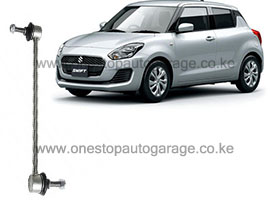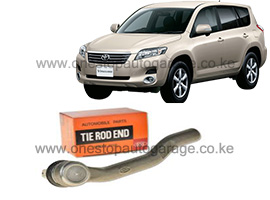-14%
Find the best Prices for Tierod End Toyota Vanguard, Rav 4 ACA31 in Nairobi, Kenya
Tie rod ends are integral components of a vehicle’s steering system, playing a critical role in ensuring precise and controlled steering. These components connect the steering linkage to the steering knuckle, allowing for the transmission of steering input from the driver to the wheels. Understanding the importance of tie rod ends and recognizing the signs of wear is essential for maintaining optimal steering performance, vehicle safety, and overall driving experience.
Importance of Tie Rod Ends:
- Steering Responsiveness: Tie rod ends are pivotal in translating the driver’s steering input into the movement of the wheels. As part of the steering linkage, these components are responsible for maintaining responsiveness and accuracy in steering, allowing the driver to navigate the vehicle with precision.
- Alignment Stability: Tie rod ends play a crucial role in maintaining proper wheel alignment. When the tie rod ends are in good condition, they help ensure that the wheels are aligned correctly, preventing issues such as uneven tire wear and contributing to the overall stability and handling of the vehicle.
- Cornering Performance: The effectiveness of tie rod ends is particularly evident during cornering. These components facilitate the smooth and coordinated movement of the wheels when turning, allowing the vehicle to negotiate corners with stability and control. Well-maintained tie rod ends contribute to a balanced and predictable cornering experience.
- Tire Wear Prevention: Properly functioning tie rod ends contribute to even tire wear. When the wheels are correctly aligned, the tires wear uniformly. Worn-out tie rod ends can lead to misalignment, causing uneven tire wear patterns and reducing the lifespan of the tires.
- Safety Enhancement: Maintaining the integrity of tie rod ends is essential for ensuring the safety of the vehicle. As a critical link in the steering system, worn-out tie rod ends can compromise steering control, leading to handling issues and potentially hazardous situations. Regular inspection and timely replacement contribute to overall vehicle safety.
Signs of Worn-Out Tie Rod Ends:
- Excessive Play or Looseness: One of the primary indicators of worn-out tie rod ends is excessive play or looseness in the steering. If there is noticeable play in the steering wheel, or if the driver experiences a lack of responsiveness when turning, it suggests that the tie rod ends may be worn and require attention.
- Uneven Tire Wear: Worn tie rod ends can result in misalignment, leading to uneven tire wear. Inspecting the tires for irregular wear patterns, such as excessive wear on one side or in specific areas, is indicative of a potential issue with the tie rod ends. Addressing misalignment promptly is crucial to prevent further damage to the tires.
- Vibrations or Shimmying: When tie rod ends wear out, they can cause vibrations or shimmying sensations in the steering wheel. These vibrations may be felt especially during acceleration or at certain speeds. Persistent vibrations suggest that the tie rod ends are not providing the necessary stability, and inspection is warranted.
- Clunking or Knocking Noises: Worn tie rod ends can produce clunking or knocking noises, particularly when the vehicle is in motion or during turns. These sounds may indicate that the tie rod ends have excessive play and are not securely holding the steering components together. Prompt inspection is crucial to identify and address the source of the noise.
- Difficulty Steering or Drifting: If the vehicle exhibits difficulty steering or tends to drift to one side, it may be a sign of worn-out tie rod ends. The inability to maintain a straight path or the need for constant steering corrections indicates a loss of steering control, necessitating a thorough examination of the tie rod ends.
- Visible Wear or Damage: A visual inspection of the tie rod ends can reveal signs of wear or damage. Cracks, tears, or visible deterioration in the rubber boots that protect the tie rod ends indicate potential issues. Additionally, if there is any noticeable play or movement in the joints, it suggests worn-out tie rod ends that require replacement.
- Leakage of Grease: Tie rod ends are typically equipped with grease boots to protect the joints and provide lubrication. If there is visible leakage of grease around the boots, it may indicate damage or wear in the tie rod ends. Inspecting for grease leakage is essential for identifying potential problems early on.
Conclusion:
Tie rod ends are indispensable components in a vehicle’s steering system, influencing steering responsiveness, alignment stability, and overall safety. Recognizing the signs of worn-out tie rod ends, such as excessive play, uneven tire wear, vibrations, or difficulty steering, is crucial for maintaining optimal steering performance and ensuring the safety of the vehicle. Regular inspections, timely replacements, and adherence to recommended maintenance schedules contribute to the longevity and reliability of tie rod ends, supporting a smooth and controlled driving experience. By understanding the importance of tie rod ends and staying vigilant for signs of wear, vehicle owners can uphold the integrity of their steering systems and promote safe journeys on the road.



